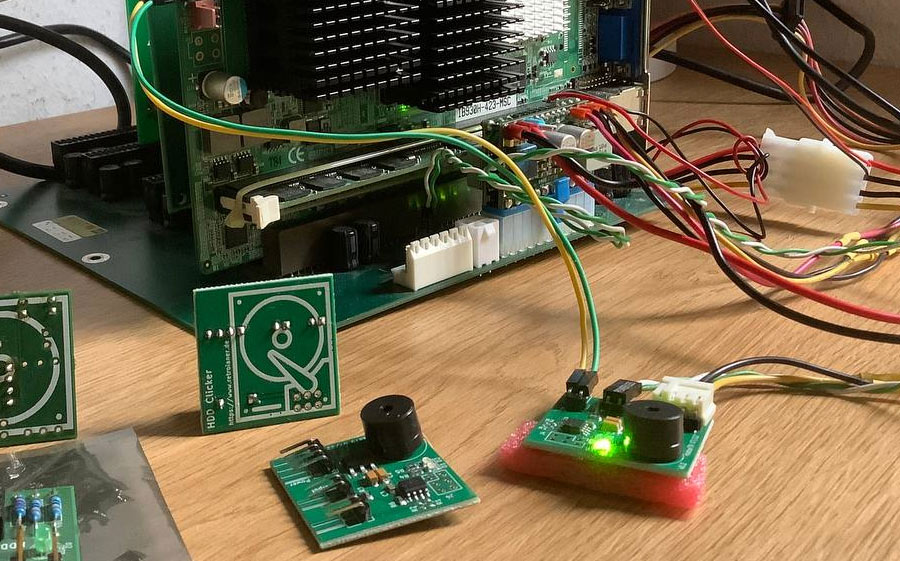HDD Clicker v0.2 Restores Aural Ambience of Pre-SSD Life
Also good for retro systems in which archaic storage has been replaced with a CF adaptor
Retro computing enthusiast Matthias Werner has shared his design for a device that recreates the characteristic operational noise of a hard disk drive (HDD).
The HDD Clicker v0.2, brought to our attention by Liliputing, is said to be both nostalgic and useful. Nostalgic for the ambience, and useful for providing audible feedback in sync with data access and transfers using your shiny new SSD (Solid State Disk).
It may be 2022, but there are still PC users out there who are only now enjoying their first delightful taste of NAND flash storage — having previously relied exclusively upon spinning rust storage. However, as with any change, some people — such as Tom's Hardware Managing Editor Matt Safford, who has promised to never buy a hard drive again — may miss aspects of what they had before.
They probably won’t miss the slower access and loading times of HDDs, or the relatively heavy weight and fragility (especially important in a laptop), but they might miss the signature clicks, ticks, and whirs an old HDD emanated when powered up and put to work. There must be some people like this, hence Matthias Werner and his €25 HDD Clicker.
The noisy gadget isn’t primarily targeted at PCs, though. As a retro computing enthusiast, Werner has upgraded various old computers with fast and capacious storage, and in a video explains that the HDD Clicker can add the missing noise to people who have added cool retro solutions to their systems, such as floppy or HDD to flash adaptors. If you watch the video you will see his retro system is an i486, and its IDE HDD has been swapped for a CF adaptor.
Werner’s design might seem rather straightforward by people experienced in putting circuit boards together and dabbling in occasional soldering tasks. At the heart of the HDD Clicker is a circuit board powered by an ATTiny microcontroller. This takes its input from your computer’s HDD activity LED pin, as well as a modicum of power from a Molex connector. Lastly, the microcontroller feeds audio in sync with drive activity to a built-in piezo speaker. Thus, it doesn’t need a driver, or any software, so it should work as soon as the computer is powered up — before and after any OS is loaded.
Though the device might be useful, we aren’t that sure whether the sound is a very accurate representation of an HDD and therefore isn't great for nostalgia in its present form. What do readers think? Checking the forums, v0.2 is of course an early version number — perhaps fair to characterize as a work in progress. Various forum users have asked for more / different sounds, so we could see the project expand or branch in the future.
Get Tom's Hardware's best news and in-depth reviews, straight to your inbox.

Mark Tyson is a news editor at Tom's Hardware. He enjoys covering the full breadth of PC tech; from business and semiconductor design to products approaching the edge of reason.
-
InvalidError My 4TB HDD is practically silent against background noise around my PC. I have to put my hand on my external HDD enclosure to tell whether the drive is spinning when the activity LED isn't blinking.Reply -
BillyBuerger Reply
Depends on your setup. I only finally replaced my second drive on my work PC from a 1TB 2.5" drive to a 512GB SSD. The HDD was pretty quiet but definitely noticable as there was only the PSU and CPU fans which run pretty slow under normal conditions. My home PC is even more quiet with the 120mm case fans all set to around 500rpms. Any spinning drive would be very noticeable there.InvalidError said:My 4TB HDD is practically silent against background noise around my PC. I have to put my hand on my external HDD enclosure to tell whether the drive is spinning when the activity LED isn't blinking. -
Alvar "Miles" Udell ReplyHowever, as with any change, some people — such as Tom's Hardware Managing Editor Matt Safford, who has promised to never buy a hard drive again — may miss aspects of what they had before.
I know the feeling, sadly 4TB and higher SSDs for NASs will likely remain out of reach for the average home user for quite some time to come. -
USAFRet This is one of the reasons we HAVE an SSD, so we don't hear that noise.Reply
But, the 11 HDDs in my NAS setup are pretty quiet.
They sit on the other side of the room, and I rarely hear them. -
boe rhae I love mechanical hard drives. Cheap, high capacity storage for data that doesn't been frequent access. Not only that, but they're a technological miracle. The read/write head controls the data with magnets. It's less than the length of a strand of DNA away from the platters without ever touching, iirc.Reply
The clicking noise is comforting for me. I understand the focus on silence, but something about hearing an HDD clicking is like witnessing magic.
One time, I took one out of an old laptop that had already been cleared of important data. I got a screwdriver and a cable, plugged the HDD in externally, and opened it up while making it move some random massive files around. Watching it work was the highlight of my week.
Maybe I'm weird. Yeah, probably.


